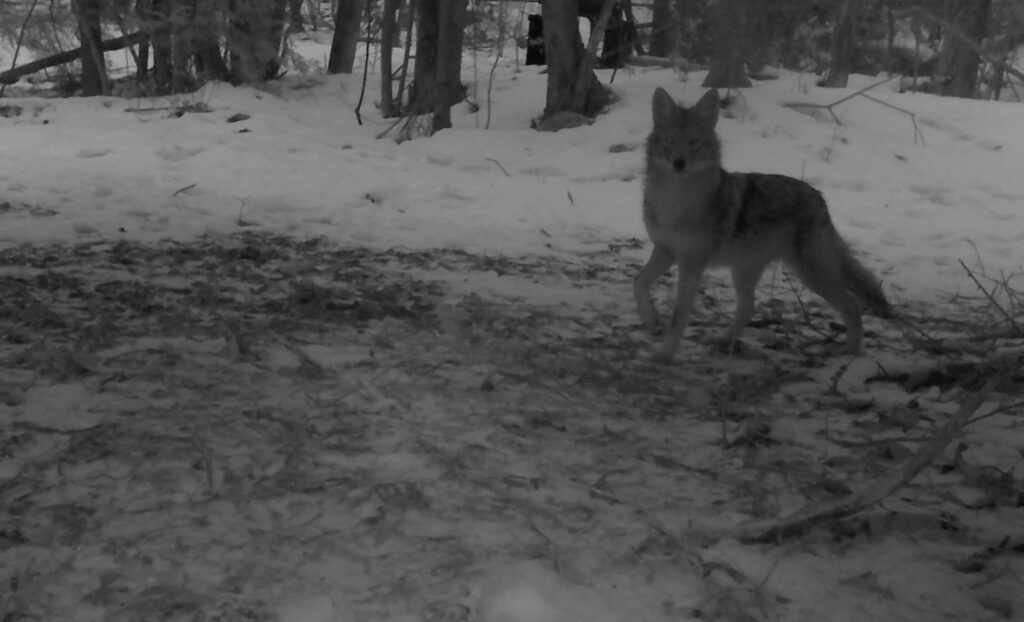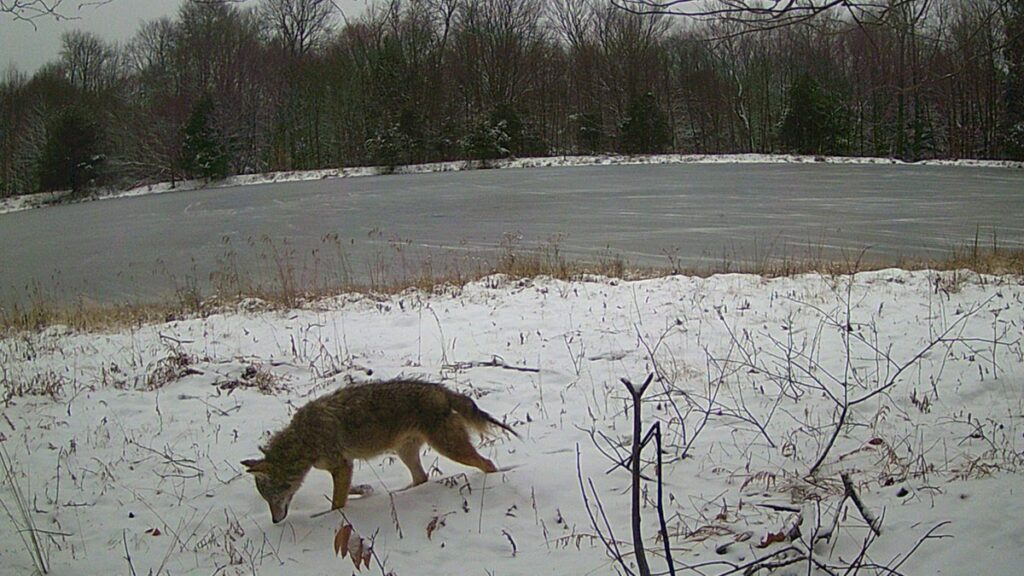Three tales of caution and a call to coexist
By Bob Confer
Earlier this week, in what has become an annual rite of spring, the New York Department of Environmental Conservation (DEC) issued guidance on preventing conflicts with coyotes.
The practice of putting out this now-routine public service announcement is something that started back in 2017. Chalk it up to a few things, such as the increased population of coyotes in suburban and urban environments, the canines’ decreasing fear of human activity, and the growing number of coyote attacks (mostly in Canada). As a higher-level predator and Man more commonly share the same habitats, there is always need for some caution, maybe even concern.
The DEC said in its press release that conflicts with people and pets can occur as coyotes tend to be territorial around den sites during the spring. Officials offered a variety of tips on how to prevent attacks on people and pets, which I’ll discuss here.
Purposeful and unintentional feeding
The DEC said property owners should not feed coyotes. They also made note that unintentional food sources attract coyotes and increase risk to people and pets. To reduce risks they said do not feed pets outside; make any garbage inaccessible to coyotes; fence or enclose compost piles so they are not accessible to coyotes; and eliminate availability of bird seed (concentrations of birds and rodents that come to feeders can attract coyotes).
All of the above certainly makes sense, not only for keeping coyotes out of your yard, but other pesky animals as well, such as opossums and raccoons and maybe even a wandering bear.
Coyotes are pretty fearless when it comes to what were traditionally the confines of Man. If you can catch online the 2014 episode of PBS’s Nature about the Eastern coyote you’ll be amazed at the overnight footage filmed with night vision in residential areas of Toronto. Stealthy and otherwise undetected, the animals would eat out of dog and cat dishes on front steps and sniff around garbage cans and bags. Then, they would just lounge around yards as unsuspecting joggers and walkers went by. It’s wild stuff.
That’s happening not only in the Big City but also out here in the rural landscape where those wild dogs are much more abundant. If I have a dusting of snow at home it shows that coyotes of various sizes traverse my lawn most every night.


Do not approach coyotes
The DEC also said that you should not allow coyotes to approach people or pets, while teaching children to appreciate coyotes from a distance. They also said that if you see a coyote, be aggressive in your behavior – stand tall, and hold arms out to look large. If a coyote lingers for too long, then make loud noises, wave your arms, throw sticks and stones.
Once again, those are common sense approaches to avoidance of conflict.
It is critical that you spend some time online or with a good field guide familiarizing your family and yourself with what a coyote looks like. You need to learn the difference between them and a “police dog” or German shepherd. But, don’t fall into the trap of thinking larger canines are not coyotes – many websites will say that coyotes top out at 45 pounds. They do out West or when they are purebred coyotes. But, the coyotes here have wolf genes and, therefore, can be large, even up to 80 pounds.
I can attest to the DEC’s statements that movement and aggressiveness can keep coyotes at bay, especially in close quarters. I’ve had five close encounters in my life. Let’s look at three of them:
A few years ago I was turkey hunting in Alma when a coyote zeroed in on my calling and thought I was a hen. The coyote quickly and quietly appeared out of nowhere, navigating the series of rises on the ridge behind me. I didn’t see or hear him until he was less than feet away, coming in from my blindside to get what he thought was an easy meal. He moved fast and was just feet away by time I could react. I raised my arm to protect my neck and face and that was more than enough to deter him as he immediately bolted upon figuring out I was a human.
Then, this past fall, I was in the lawn of our cabin in Alma admiring the nighttime skies when a coyote came right up to me! I let out a guttural noise, a sort of yell that was a clumsy reaction, and the canine bolted.
But, being a loud, large and angry human doesn’t always work (although it does most of the time), and I’m surprised the DEC didn’t touch on the fact, even briefly, that coyotes can have rabies, both from being a social animal and from feeding on common carriers of rabies.
A perfect example is what happened in the city of North Tonawanda in Niagara County a few years back. A fearless coyote was seen a few times in the city. One morning, when I arrived at work, the coyote was in our driveway and couldn’t care less about my truck being alongside him. I purposely parked next to him, rolled down my window, and said “skedaddle!”. He never ran off. Two days later and a few blocks away, the coyote bit a man who went to pet him thinking it was a small shepherd (it was the third coyote bite in the city!). When police finally caught up with the coyote, the sickened dog came up to the officer’s cruiser and even attempted to climb it before being shot. Of course, the predator tested positive for rabies.
Do not allow pets to run free
The DEC said it’s critical to supervise all pets, especially outdoor pets, to keep them safe from coyotes and other wildlife, especially at sunset and at night.
They say small cats are especially vulnerable to coyotes. That is something I know too well. In high school one of our favorite cats was out at night when a coyote killed her…only for the sake of killing her. The coyote didn’t eat the cat, it only eliminated a threat. Coyotes don’t want to co-exist with other carnivores that might be pursuing some of their favorite foods like mice.
The DEC also says that owners of small dogs should have cause for concern. I agree, for the same reason the coyote killed the cat – coyotes don’t like competition.
I’ve seen the outcome of this in the natural world on a couple of occasions, with foxes being the small dogs in question.
A few winters ago winter ago, coyotes had brought down a deer near my house. A few days later there was a dead red fox lying just 60 yards away from what remained of the deer. It had a few puncture wounds from teeth in it, coyotes being the culprit. We took the fox to a coworker so he could produce a pelt and he said when he skinned it the skeleton virtually fell apart because the coyotes were strong enough to snap the fox’s back and multiple ribs.
Then, two years ago, coyotes came in to my yard at night and decimated a family of fox young that were born and raised in my shed. The larger dogs tore the kits to shreds – there were limbs and heads everywhere — and they never ate any of the foxes’ meat.
If you don’t want your pup to end up like that, the DEC says small dogs should not be left unattended in backyards at night and should remain supervised.
There’s a lot to digest here and it’s certainly worthwhile to ponder as coyotes become more numerous and more brazen. Some of what the DEC has said and certainly some of the things I’ve written here may strike some fear in your heart. Please, as with all wild creatures, don’t fear them: we need to understand these canine neighbors and approach these animals with respect – and a little common sense.
Some people think that coyotes are moving into our domain. But, one could argue that it was theirs to begin with. So, let’s share this world with them.








